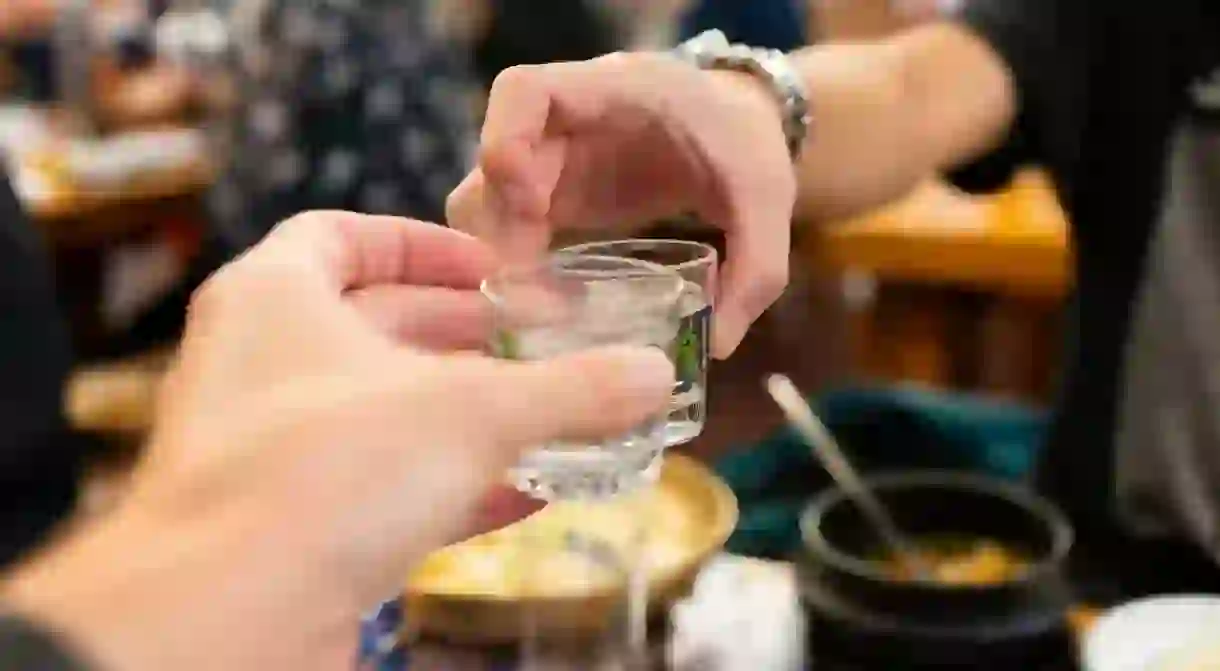A Guide to Korea's Spirits

You’ve probably heard of soju. You might have even heard of makgeolli. But have you heard of bokbunjaju, cheongju or beolddeokju? Here’s our guide to Korea’s best spirits to tickle your tippling fancy. Geonbae!
Did you know – Culture Trip now does bookable, small-group trips? Pick from authentic, immersive Epic Trips, compact and action-packed Mini Trips and sparkling, expansive Sailing Trips.
Rice fermentation
Korea’s most popular spirits are made from rice, Asia’s staple food. To turn it into liquor, the rice is cooked in water and yeast, sweetener and nuruk (a traditional Korean fermentation starter) is added. This mixture is then fermented over varying periods of time to produce alcohol. A lot of alcoholic drinks end in the suffix –ju; this just means ‘alcohol’.
Soju

Soju is the most popular liquor in South Korea, and one of the best-selling spirits in the world. Its popularity owes much to its cheapness — a typical 335-millilitre soju bottle will set you back around 1,700 won (£1.15/US$1.55) at a convenience store. Traditionally, soju is made from rice, but many mass-produced brands now use ethanol derived from sweet potatoes. This practice is a relic from leaner times; in 1965, a rice shortage briefly led to a government ban on using rice to make soju. Although it’s rarely a gentle drink — it’s generally consumed for the sake of getting drunk, and its abrasive flavours are an acquired taste — it pairs very well with Korea’s punchy, meat-heavy cuisine, and hot, crispy fried bar snacks (known as anju). Some more expensive brands use techniques such as barrel-ageing to draw out more complex flavours, but generally it’s a fairly straight-up, distilled spirit. Fruity soju flavours are targeted to the youth market; they come in flavours such as pomegranate and blueberry. They’re sweeter than regular soju, with a lower alcohol content.
Makgeolli
Makgeolli is Korea’s oldest alcoholic drink. It’s been brewed for nearly 2,000 years, and it’s easily quaffable thanks to its low alcohol percentage (normally around six to nine percent). Although it’s not always been fashionable — another name for it is nongju, which means ‘farmer’s wine’, as it was traditionally associated with the working classes and agricultural peasants — it’s always been widely drunk. It is an unfiltered beverage, so in contrast to soju it has an opaque, milky appearance and contains sediment. It’s sweet in flavour, with a mild tangy kick and a lightly carbonated fizz, and pairs perfectly with spicy Korean foods.
Cheongju
Traditionally, cheongju was consumed by the Korean royal court. It is made using the same rice fermentation process as makgeolli, but whereas makgeolli uses the bottom layers of the fermented liquor, cheongju uses just the clear liquid that rises to the top. It’s therefore slightly more pure and less likely to induce hangovers (although obviously this depends on the quantity ingested). Cheongju is important in Korean tradition; as it’s seen as a ‘good’ (well-made) liquor, it’s used in rituals and offerings, including ancestral rites. It’s the Korean spirit closest to Japanese sake.
Fruit wines

South Korea has a wide variety of fruit wines; although they’re not as well known as rice wines, fruit wines are arguably some of the tastiest drinks made in the country. One of the most popular is bokbunjaju, which can be found in every convenience store for around 6,000-7,000 won (£4.10-£4.80/US$5.40-6.30). This wine is made from Korean black raspberries (bokbunja). It’s dark red, tart and sweet, and believed to have health benefits including increased male stamina. Maesilju, or plum wine, is also popular. Plum wine is based on soju, and infused with either yellow or green plums. It’s moderately sweet and normally matured for at least three to six months, which gives the wine a more complex, mellow flavour. Other wines are made with fruits and flowers including grapes, apples, pomegranates, cherries, peaches, lotuses, yuzu and roses.
Medicinal spirits
Korean traditional medicine includes a variety of health-giving spirits (yagyongju). These are distilled with alcohol, roots, herbs and seeds. Nowadays they are generally consumed more for their recreational than their medicinal properties. Baekseju is one of the most popular, especially amongst young people, who often prefer its taste to the harsher soju. It is a rice-based wine, which is then infused with twelve herbs including ginseng, liquorice, ginger and cinnamon. Another popular medicinal spirit is chuseongju, which can be recognised by its bamboo-shaped bottle. It’s made to a traditional recipe, from rice and herbs. Beolddeokju is another easily recognised medicinal spirit; it’s believed to increase male stamina, and is sold in a phallic-shaped bottle, with a smiling ceramic face on the top. One for the brave is bemju; this distilled liquor is made by taking a jar of a spirit such as soju, adding a dead snake and setting the jar aside to age. The more poisonous the snake, the better — it’s a folk remedy which is believed to be most effective with a more venomous beast.













